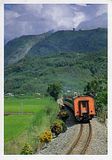
 (postal card) Velbert is a town in the district of Mettmann, in North Rhine-Westphalia, Germany. Langenberg, a district of Velbert, is well known as the location of the Sender Langenberg transmitter site.Velbert is located in the hills of the Berg region, approx. 20 kilometres north-east of the state capital Düsseldorf and 12 kilometres north-west of Wuppertal on the left side of the Ruhr river. Velbert stands on the highest part of the Berg region and also in its centre. Its average elevation is around 230 metres above sea level; its highest point, at 303 metres, is the Hordt-Berg and its lowest, at around 80 metres, is in Nierenhof am Deilbach. The highest point in Velbert itself is 263 metres above sea level, at the corner of Friedrichstraße and Langenberger Straße.
(postal card) Velbert is a town in the district of Mettmann, in North Rhine-Westphalia, Germany. Langenberg, a district of Velbert, is well known as the location of the Sender Langenberg transmitter site.Velbert is located in the hills of the Berg region, approx. 20 kilometres north-east of the state capital Düsseldorf and 12 kilometres north-west of Wuppertal on the left side of the Ruhr river. Velbert stands on the highest part of the Berg region and also in its centre. Its average elevation is around 230 metres above sea level; its highest point, at 303 metres, is the Hordt-Berg and its lowest, at around 80 metres, is in Nierenhof am Deilbach. The highest point in Velbert itself is 263 metres above sea level, at the corner of Friedrichstraße and Langenberger Straße. Bernhard Klemens Maria Grzimek was a renowned zoo director, zoologist, book author, editor, and animal conservationist in postwar West-Germany. After studying veterinary medicine in 1928, first at Leipzig and later in Berlin, he received a doctorate in 1933. After World War II he became director of the Frankfurt Zoological Garden, then in ruins, which he made into one of the largest zoological gardens in Germany. At the same time he served as president of the Frankfurt zoological society for over forty years. The society - organized on similar principles as its London and New York counterparts - runs a number of wildlife conservation projects both in Germany and overseas; most well-known is its ongoing work in the Serengeti ecosystem in Tanzania, East Africa.
Bernhard Klemens Maria Grzimek was a renowned zoo director, zoologist, book author, editor, and animal conservationist in postwar West-Germany. After studying veterinary medicine in 1928, first at Leipzig and later in Berlin, he received a doctorate in 1933. After World War II he became director of the Frankfurt Zoological Garden, then in ruins, which he made into one of the largest zoological gardens in Germany. At the same time he served as president of the Frankfurt zoological society for over forty years. The society - organized on similar principles as its London and New York counterparts - runs a number of wildlife conservation projects both in Germany and overseas; most well-known is its ongoing work in the Serengeti ecosystem in Tanzania, East Africa.Grzimek is most famous for the work he undertook for the conservation of the Serengeti. He spent several years studying the wildlife there along with his son Michael, especially on areal observation and counts of large scale annual migrations. In 1959 Michael was killed in an aircrash while flying the Dornier Do 27 due to a collision with a Griffon Vulture. He wrote a best-selling book called Serengeti shall not die, which appealed enormously to the public and was key in driving the creation of the Serengeti National Park.































No comments:
Post a Comment